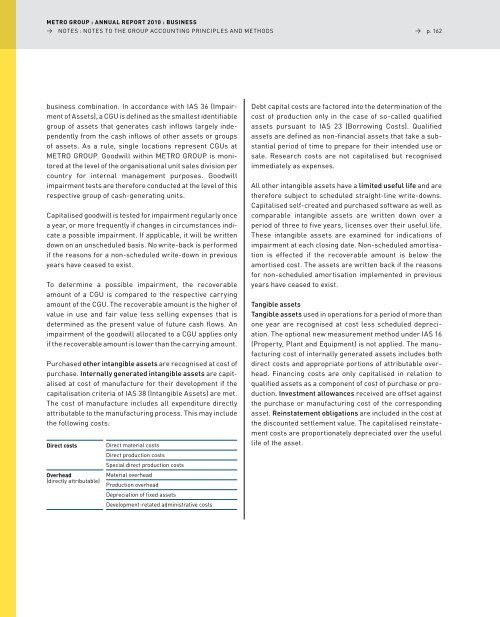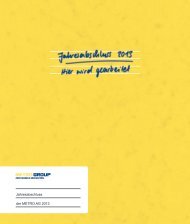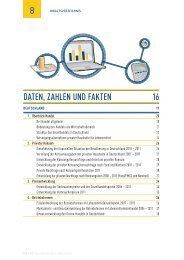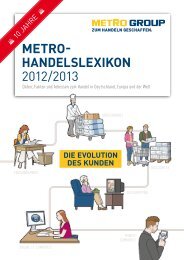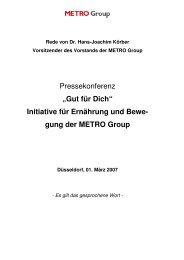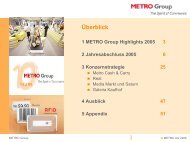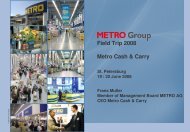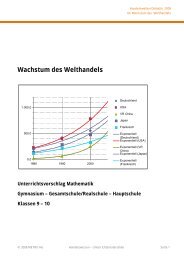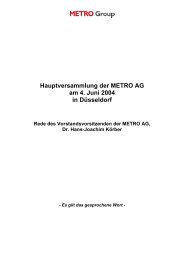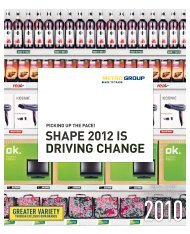pdf (2.5 MB) - METRO Group
pdf (2.5 MB) - METRO Group
pdf (2.5 MB) - METRO Group
You also want an ePaper? Increase the reach of your titles
YUMPU automatically turns print PDFs into web optimized ePapers that Google loves.
<strong>METRO</strong> GROUP : ANNUAL REPORT 2010 : BUSINESS<br />
→ NOTES : NOTES TO ThE GROuP ACCOuNTING PRINCIPlES ANd METhOdS<br />
business combination. In accordance with IAS 36 (Impairment<br />
of Assets), a CGu is defined as the smallest identifiable<br />
group of assets that generates cash inflows largely independently<br />
from the cash inflows of other assets or groups<br />
of assets. As a rule, single locations represent CGus at<br />
<strong>METRO</strong> GROuP. Goodwill within <strong>METRO</strong> GROuP is monitored<br />
at the level of the organisational unit sales division per<br />
country for internal management purposes. Goodwill<br />
impairment tests are therefore conducted at the level of this<br />
respective group of cash-generating units.<br />
Capitalised goodwill is tested for impairment regularly once<br />
a year, or more frequently if changes in circumstances indicate<br />
a possible impairment. If applicable, it will be written<br />
down on an unscheduled basis. No write-back is performed<br />
if the reasons for a non-scheduled write-down in previous<br />
years have ceased to exist.<br />
To determine a possible impairment, the recoverable<br />
amount of a CGu is compared to the respective carrying<br />
amount of the CGu. The recoverable amount is the higher of<br />
value in use and fair value less selling expenses that is<br />
determined as the present value of future cash flows. An<br />
impairment of the goodwill allocated to a CGu applies only<br />
if the recoverable amount is lower than the carrying amount.<br />
Purchased other intangible assets are recognised at cost of<br />
purchase. Internally generated intangible assets are capitalised<br />
at cost of manufacture for their development if the<br />
capitalisation criteria of IAS 38 (Intangible Assets) are met.<br />
The cost of manufacture includes all expenditure directly<br />
attributable to the manufacturing process. This may include<br />
the following costs:<br />
Direct costs direct material costs<br />
direct production costs<br />
Special direct production costs<br />
Overhead<br />
Material overhead<br />
(directly attributable)<br />
Production overhead<br />
depreciation of fixed assets<br />
development-related administrative costs<br />
→ p. 162<br />
debt capital costs are factored into the determination of the<br />
cost of production only in the case of so-called qualified<br />
assets pursuant to IAS 23 (Borrowing Costs). qualified<br />
assets are defined as non-financial assets that take a substantial<br />
period of time to prepare for their intended use or<br />
sale. Research costs are not capitalised but recognised<br />
immediately as expenses.<br />
All other intangible assets have a limited useful life and are<br />
therefore subject to scheduled straight-line write-downs.<br />
Capitalised self-created and purchased software as well as<br />
comparable intangible assets are written down over a<br />
period of three to five years, licenses over their useful life.<br />
These intangible assets are examined for indications of<br />
impairment at each closing date. Non-scheduled amortisation<br />
is effected if the recoverable amount is below the<br />
amortised cost. The assets are written back if the reasons<br />
for non-scheduled amortisation implemented in previous<br />
years have ceased to exist.<br />
Tangible assets<br />
Tangible assets used in operations for a period of more than<br />
one year are recognised at cost less scheduled depreciation.<br />
The optional new measurement method under IAS 16<br />
(Property, Plant and Equipment) is not applied. The manufacturing<br />
cost of internally generated assets includes both<br />
direct costs and appropriate portions of attributable overhead.<br />
financing costs are only capitalised in relation to<br />
qualified assets as a component of cost of purchase or production.<br />
Investment allowances received are offset against<br />
the purchase or manufacturing cost of the corresponding<br />
asset. Reinstatement obligations are included in the cost at<br />
the discounted settlement value. The capitalised reinstatement<br />
costs are proportionately depreciated over the useful<br />
life of the asset.


